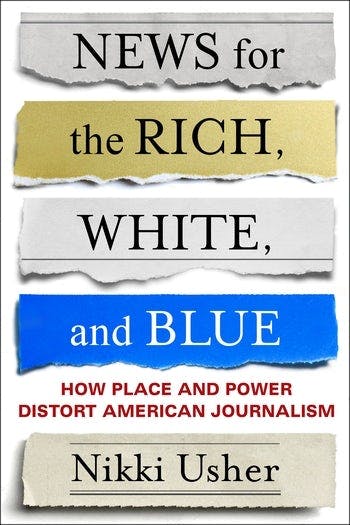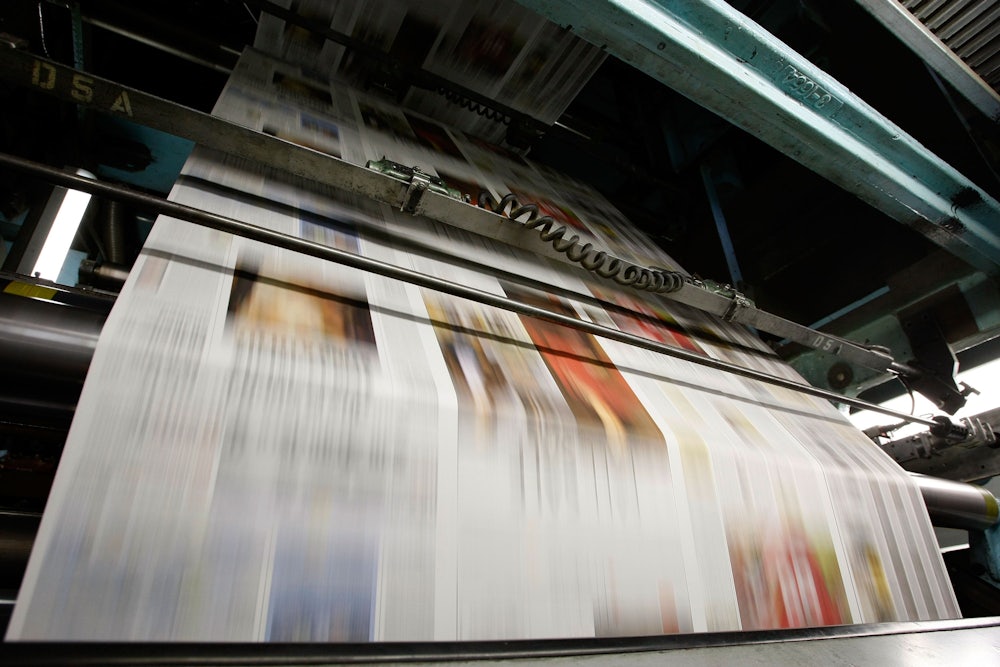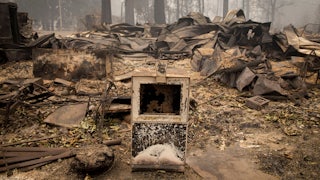For an industry that prides itself on hard-bitten bullshit detection, journalism has long relied on fables of civic uplift to supply its reason for being. The mission of American journalism is broadly understood to be essential to the functioning of our democracy, by cultivating and empowering an informed citizenry. In a republic predicated on an ideal of rough social equality, knowledge is indeed power—and when knowledge ceases to circulate in wide and open channels, the prospects for democratic renewal dim accordingly.

That civic mission is being severely tested, especially at midsize newspapers, which have lost their major source of revenue—advertising—and swathes of their readers in recent decades. In News for the Rich, White, and Blue, Nikki Usher traces the struggles of “those metropolitan and regional newspapers that are not quite local and not quite national” against the industry-wide conditions of “market failure” that have produced a wave of layoffs and bankruptcies throughout the sector. Many once-robust journalism markets, as a result, are becoming news deserts, without any regular reporters keeping watch on the areas’ political economies and their major players. And into this gaping civic vacuum, she notes, a battery of placeless digital news operations grabs the attention of underserved readers and audiences. These lightly regulated and nationally scaled outlets, often nestled within monopoly platforms like Google and Facebook, are geared to optimize online engagement—which is to say that they harvest clicks with, at best, notional standards of truth-telling and even sketchier structures of local accountability.
But the rise of content farms in place of regional newspapers is only one part of journalism’s crisis. For in their attempts to stay financially afloat, many of the midsize news organizations that have survived have gradually relinquished their long-standing mission to keep a broad public informed. As publications increasingly rely on subscription revenue for their income, they are available to fewer and fewer people and find themselves with audiences who are much wealthier than the mass audiences they once engaged; increasingly, Usher notes, publications are “prioritizing the audiences that can and will pay.”
“Those who have access and entry into the newsroom get to mold the coverage we see,” Usher writes. “Those who pay for news will increasingly direct where journalists direct their scarce resources.” The distressing upshot, Usher writes, is that “the kind of journalism that is important for a healthy democracy is increasingly undemocratic; made for and by the rich, white, and ‘blue.’” (That would be “blue” as in “Democratic,” according to the two-party electoral maps that have overtaken so much of our political discussion.) The broader logic of this shift, Usher argues, has converted journalism from its former status as a guardian of the public weal into a “private good,” subject to all the familiar insulated and exclusionary market pressures that attach to any such commodity in our top-heavy, plutocratic social order. But her account of this baleful process, and her appraisal of its prospective remedies, ultimately lapses into the very sort of above-the-fray difference-trimming that helped land American journalism in its present pass. And just as confusingly, Usher uncritically relies on the great culture-war fable of incorrigible liberal bias to reenvision a more locally anchored and responsive media ecosystem.
Her analysis is spot-on in its main thrust: Relentlessly upward-skewing market conditions have created plenty of carnage in the whipsawed newspaper sector. To take just one example, the Youngstown Vindicator, a 150-year-old Ohio paper with a history of covering the area’s distressed working-class and nonwhite communities, shut down as its market succumbed to full-scale news desertification. The Monday before its closure, Usher notes, the paper ran a total of eight column inches of advertising, “roughly the length of a newspaper’s crime blotter.”
But the shuttering of the Vindicator was only the last act in a steady retreat of more affluent readers from the local journalism scene. Amid its “early experiments in online news,” Usher writes, the paper “retained its emphasis on covering the city’s distressed, mostly Black, urban core.” But the Vindicator was still struggling:
Those better off and living in the five-county region’s outlying suburbs have another newspaper and local television stations to turn to, not to mention speedy Wi-Fi connections. For onlookers who have an unimpeachable faith in the connection between news and democracy, it was alarming that Youngstown proper, a poor, left-leaning area, was now without journalists, and especially vulnerable to unchecked corruption and misinformation.
The Vindicator has since relaunched under new ownership, but it is a faint shadow of its former civic self, with both “quasi-local ownership and minimal local coverage.”
News is increasingly being repositioned as a private good in an array of settings. The New York Times, the great outsize outlier in the fiercely straitened news economy, has staked its prospects on a globe-bestriding operation that “aims to conquer place by scale,” she notes. But here again, the broader packaging of news as a private good flattering the sensibilities of an insulated elite is all too plain. The core of the Times campaign, Usher proposes, has been to leverage the elite European readership of the now retired Times-owned property the International Herald-Tribune—“a newspaper for the one percent” in Usher’s apt assessment—into a far more thoroughgoing vision of the model news organization as an information valet for a global elite. The defining sense of place that anchors so much vital reporting has been, not surprisingly, an early casualty of this strategy; the Times has nimbly dispatched reporters out of its central international hubs in London and Hong Kong to cover investment-minded trends and luxury leisure stories, while the Times’ local news presence diminishes accordingly:
In 2017, the Times announced it was cutting back on “incremental coverage” of New York City as it pursued a global growth strategy and had also decided to shelve regional arts and culture coverage. Comparisons of news coverage actually about New York from the early 2000s to 2017 show roughly one-half to two-thirds fewer New York-specific cities mentioned, and staff counts suggest that the metro desk had shrunk by half over that timeframe.
Lydia Polgreen, the former director of the NYT Global project, summed up the underlying demographic logic bluntly in an interview with Usher: “The rise of the Times as a global news organization in some ways mirrors a rise in inequality, where there is a global class of connected citizens who rely on a handful of preferred, largely English, sources of news and information.” After all, Polgreen notes, “there are a lot of similarities between a wealthy, well-educated person living in Singapore and a wealthy, well-educated person living in New York.”
The background worldview of this upper-crust demographic is broadly liberal. Like other media critics, Usher bemoans the hoary trope of the “Trump safari”—the reflexive impulse across many elite liberal news outlets to dispatch intrepid anthropological teams of reporters into heartland diners and other small-town venues to chronicle the mores and thought processes of the mysterious, exoticized Trump supporter. At other times, though, she hitches her argument to a just-as-exhausted culture-wars talking point: the notion that the “blue”-leaning geography of today’s journalism markets translates into across-the-board liberal bias in news coverage. “The loudest voices in American public discourse belong to those journalists with perspectives limited by minimal day-to-day exposure to those who don’t live in big cities like them,” she writes:
Barry Goldwater’s maligned “eastern liberal press” is becoming the only general-interest news option available to many. Goldwater, originally from Arizona, would find that present-day Arizona’s news consumers pay little attention to anything other than the national news media he taunted. Arizona … has lost significant numbers of journalists, and local news traffic is tiny.
This is fair enough as far as it goes—but of course the “eastern liberal press” Goldwater castigated in the early 1960s was already a caricature of culture-war invective, and exists in a far more notional manner half a century later. Because Usher is writing mostly about the newspaper industry, she doesn’t linger much on the TV empires of Fox News and Sinclair Broadcasting, which pump out right-wing agitprop in wall-to-wall fashion, with enormous profit margins—especially in graying demographic markets like the metro centers of Arizona. (One America News Network, meanwhile, the most aggressively Trumpist broadcasting fiefdom in cable television and one that was mobilized on a made-to-order basis by senior management at DirectTV’s parent company, AT&T, gets no mention at all.)
Who will save journalism from this state of acute and unequal bifurcation? Over the past decade, we’ve witnessed a steady rise in philanthropy journalism, with donor cash backing ambitious national and global investigative reporting under the aegis of operations such as Pro Publica and the Center for Public Integrity. But Usher observes that the donor-backed business model—a highly touted rescue plan for the most market-averse forms of journalism, such as in-depth feature coverage and investigative projects—has tended to accelerate, rather than stanch, the dynamics converting reporting into a private good. In a moment of runaway plutocratic privilege and right-wing autocracy, politically minded journalism desperately needs reinvestment in essential, if unglamorous, coverage of statehouses, school boards, and other local and regional power centers. Yet nonprofit funders of journalism have not tended to throw money in this direction: In a study of the mismatch between reporting needs and resources in markets across all 50 states, Usher found that there is in fact “little relationship between news deficits and philanthropic support, though there are some indications that support for journalism is going to places better provisioned for news than others.” It’s also the case, she finds, that “blue states get more funding than red ones.” In this, she sees evidence of predictable donors’ sensibilities and cultural preferences: “Big-city philanthropists give to big-city grantees and college towns.”
One 2018 Shorenstein Center survey of self-reporting philanthropies supporting journalism found that fully 44 percent of the $1.8 billion spent on news outlets from 2010 to 2015 went to legacy public TV and radio stations already firmly ensconced as targets of institutional largesse, while the audiences for recipient news organizations likewise overlapped with “those already reading outlets like The New York Times and The Washington Post.” The flow of donor cash, in short, tends to promote “more journalism for the wealthy and informed,” with predictably top-heavy results: “Eight of ten foundation dollars flowed to just twenty-five news nonprofits, and while four investigative journalism outlets topped the list, none focus on state or local issues, even though state and local journalism, particularly investigative journalism, appears to be most under threat.” She laments, as well, that “five out of the six states that did not get any funding for investigative journalism were Republican.”
Usher is not convinced, in any case, that foundation funding would help local news organizations. She worries that the flow of liberal foundation dollars into underserved journalism markets would create the appearance of liberal bias in the reporting of those publications. Discussing a pair of recent local reporting startups in Mississippi and West Virginia, she argues that their longer-term prospects are “vulnerable to backlash and accusations of media bias from the right,” thanks to the grants they’ve acquired from liberal donors. At bottom, she suggests, the perception of foundation funding as a glorified form of ideological carpet-bagging jeopardizes public trust in such news organizations: “Authenticity is easily tarnished by any associations that these outlets have from outside their region. Being viewed as an ‘outsider’ looking in on the state’s or region’s problems can make it harder for the outlets’ work to have an impact, especially if the journalism can be dismissed as having liberal motives.”
She even suggests something akin to a program for ideological parity in news funding to combat the perception of hostile coastal-elite takeovers of heartland news deserts. She notes that “Republican funders are not necessarily welcomed into the general-interest news philanthropy space,” mostly on the strength of industry criticism aimed at the American Society of Newspaper Editors and Poynter Institute for taking money from the right-wing megadonors at the Koch Foundation. For Usher, it’s simply taken as read that “in the current political climate, and with the current state of financial pressure on journalism, the implicit partisanship associations about the flow of dollars to news outlets matter.”
The local trust issues of vulnerable local news startups are real, and cries of rampant liberal media bias from the right certainly complicate such challenges, but nothing is gained by simply capitulating to such charges for the sake of appearing nonpartisan. (Indeed, Usher herself seems to half-recant the gist of this recommendation in the book’s concluding chapter, which argues for the revival of a forthright “partisan local media.”)
What’s more, of course, the foundation money that flows into local news startups is nothing compared to the billions of dollars in in-kind campaign coverage that mainstream news organizations lavished on Donald Trump’s 2016 campaign, and the logistical and micro-targeting support that Facebook gave to Trump during his ascendancy. The effects of donor funding certainly bear scrutiny, but simply looking for a wider range of donors or having them spread their cash more evenly across the country isn’t going to save the news.
No, a more robust and small-d democratic media landscape calls for much more thoroughgoing reforms, with a more comprehensive and equitable funding model from the public sector, along the general lines of the TV tax that funds the British Broadcasting Corporation, and an aggressive antitrust campaign to break up the Facebook and Google platform monopolies. The basic components of this case are laid out clearly in the main body of News for the Rich, White and Blue, but Usher’s book ultimately comes to rest on the very overbroad cultural determinism that has decimated the ideal of public-minded journalism in the first place. Some fables, it seems, are far harder to extinguish than others.








